Posts Tagged ‘picture books’
Sunday, July 10th, 2022
“The idea of the extraordinary happening in the context of the ordinary is what’s fascinating to me.” – Chris van Allsburg
Picture books by Chris van Allsburg are not only beautifully illustrated, the stories are wide open for wide interpretation, which makes them ideal for children. It’s impossible to look at the pictures in Harris Burdick without imagining a story. My other surreal favourites are Bad Day at Riverbend, about a black and white cowboy town attacked by colourful crayons – and The Wretched Stone, about a strange glowing stone which makes the people regress intellectually (TV and digital screens perhaps?).
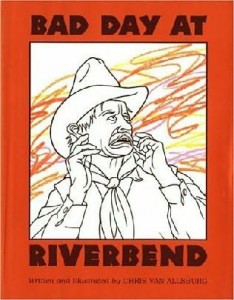
Tags: books, children's books, picture books, reviews
Posted in Book Reviews, Children's Books | No Comments »
Saturday, June 4th, 2022
Miss Clavel turned on the light and said, “Something is not right!” – Madeleine
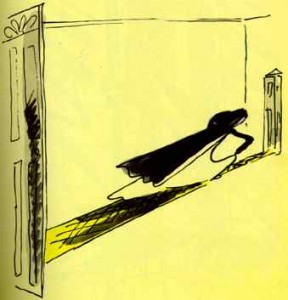
You’ve written a wonderful story and can’t wait to publish it. But wait! Hide your story away for weeks, even months. When you read it again it will be like turning on the light and you’ll see what’s not right – you’ll see with fresh eyes. I’m often too hasty as a writer, but after a pause, I get that Miss Clavel feeling when a scene doesn’t fit or a character speaks in clichés – when the ‘story dream’ is broken.
Illustration from the timeless book, Madeleine, by Ludwig Bemelmans.
Nothing must be out of place. The reader must keep turning pages with no interruptions in the flow. – Darcy Pattison
Go over and over it…refusing to let anything stay if it looks awkward, phony, or forced.– John Gardner
Tags: picture books, writing
Posted in Writing | No Comments »
Wednesday, April 1st, 2020
Draw to live; live to draw – Wanda G’ag
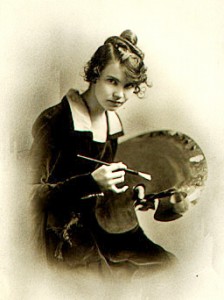 Meet Wanda G’ag (it rhymes with blog) one of the finest children’s book illustrators. Her masterpiece is Millions of Cats (1928) the story of a lonely old couple who attract ‘millions and billions and trillions of cats‘. The pictures roll like waves across the pages; clouds, trees, hills, and cats all swept along in the flow of the story. The black and white gives it a slightly unsettling folktale vibe. As a child I loved the army of cats drinking a pond in seconds, and the final catastrophic cat-scrap. And try to find her bizarre but cute book Nothing At All, about an invisible dog.
Meet Wanda G’ag (it rhymes with blog) one of the finest children’s book illustrators. Her masterpiece is Millions of Cats (1928) the story of a lonely old couple who attract ‘millions and billions and trillions of cats‘. The pictures roll like waves across the pages; clouds, trees, hills, and cats all swept along in the flow of the story. The black and white gives it a slightly unsettling folktale vibe. As a child I loved the army of cats drinking a pond in seconds, and the final catastrophic cat-scrap. And try to find her bizarre but cute book Nothing At All, about an invisible dog.
Tags: children's books, picture books, writers
Posted in Children's Books | No Comments »
Sunday, March 1st, 2020
It was 1963, and I was terrified on my first day at school. I sat on the hard grey carpet mat, and the teacher read Horton Hatches the Egg to the class. I became so engrossed I didn’t even notice my mother slip out. That loyal elephant helped me get through that watershed day without too many waterworks. Soon I had other beloved Seuss friends at school including the Pale Green Pants and the Zizzer Zazzer Zuzz. Seuss thrived on the constraints of the English language – for Green Eggs and Ham he was given a 50 word vocabulary list to work with, and created a classic. And take heart writers, his first book was rejected 27 times.
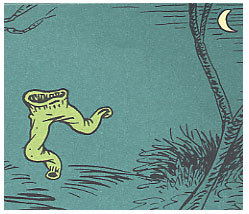
Tags: children's books, picture books, Seuss
Posted in Children's Books | No Comments »
Saturday, November 30th, 2019
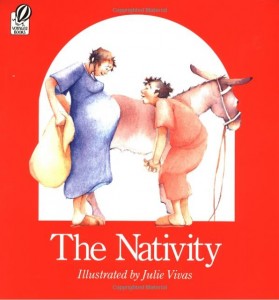 The Nativity, illustrated by Julie Vivas, is my favourite children’s Christmas book. The pictures convey the humanity of the story by showing the love between Mary and Joseph, the pregnancy and birth, within a rustic setting. Oddly, it all sits well with the poetic language of the 17th century King James version of the Bible. Vivas also illustrated the wonderful book for babies, I Went Walking.
The Nativity, illustrated by Julie Vivas, is my favourite children’s Christmas book. The pictures convey the humanity of the story by showing the love between Mary and Joseph, the pregnancy and birth, within a rustic setting. Oddly, it all sits well with the poetic language of the 17th century King James version of the Bible. Vivas also illustrated the wonderful book for babies, I Went Walking.
Tags: children's books, picture books, reviews
Posted in Book Reviews, Children's Books | No Comments »
Sunday, June 30th, 2019
Sylvester and the Magic Pebble by William Steig is a picture book about a child’s fear of separation; it won the Caldecott Medal in 1969. The brilliantly absurd plot has Sylvester the young donkey trapped inside a rock while his parents search frantically for him. It’s Steig’s version of his favourite book, Pinocchio, about a boy trapped inside a piece of wood. The ending is typical Steig: the child reunited with loved ones in with hugs and tears – when he was 15 years old, young William ran away to sea after an argument with his father:
When I finally got home, my mom and dad hugged and kissed me and we all cried. We were a very emotional family.
Read more about Steig and his life-affirming books.
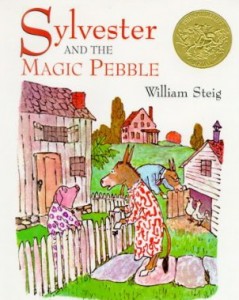
Tags: children's books, picture books, steig
Posted in Children's Books | No Comments »
Saturday, February 2nd, 2019
Ferdinand (1936) by Munro Leaf is one of the most influential children’s books because of its simple but powerful theme. The tale of a bull who likes to smell flowers instead of fighting was seen as a pacifist text at the time of the Spanish Civil War.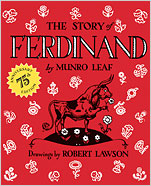 Ferdinand chooses to be himself rather than follow the aggressive crowd. No wonder the book was:
Ferdinand chooses to be himself rather than follow the aggressive crowd. No wonder the book was:
Read the true story of the bull who inspired it: The Marginalian.
Munro Leaf also wrote books which reflected the stricter child-raising style of his time. 3 and 30 Watchbirds (1941) condemns children’s behaviours such as shoe-scuffing, mumbling, moaning, fidgeting, and wasting food. Some of it’s in the spirit of war-time frugality, but some is just plain excessive:
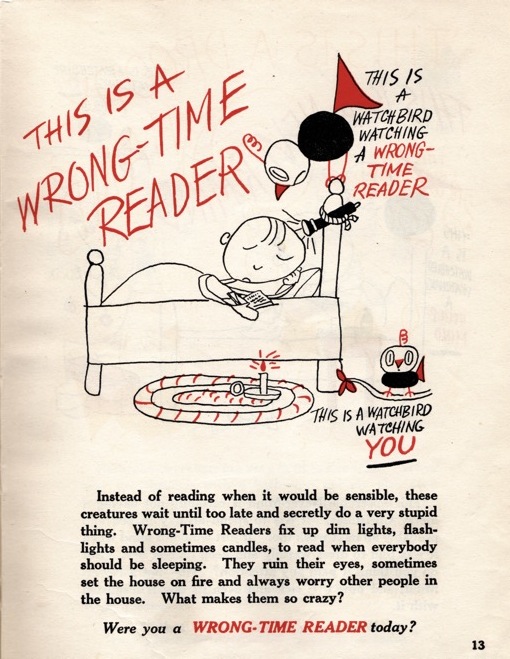
Grammar Can Be Fun is slightly more tongue-in-cheek and warns children against slack language such as “gimme, wanna, gonna, and ain’t”.
Tags: children's books, classics, Peace, picture books
Posted in Book Reviews, Children's Books, Peace | No Comments »
Saturday, June 9th, 2018
That touch of reality in a child’s life is a child’s comfort. The child gets the sense that this person who wrote this book knows about me and knows the world can be a troubling, incomprehensible place. Maurice Sendak
Outside Over There is my favourite Maurice Sendak picture book – – nobody else combined the real and the unreal so well. It’s a tale of separation and siblings (that features a creepy ice baby) and is both haunting and comforting. 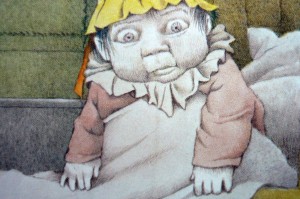
Sendak’s books can be exuberant (In the Night Kitchen), spiritual (Dear Mili), and funny (Pierre, a cautionary tale). I like his vision of atoms dancing to form molecules from the first book he illustrated (when 19 years old), Atomics for the Millions:
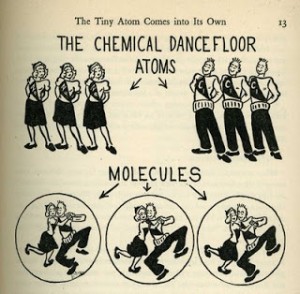
Tags: books, children's books, picture books, reviews
Posted in Book Reviews, Children's Books, Writing | 1 Comment »
Sunday, June 4th, 2017
Not another pirate picture book! Yes, but a beautifully offbeat one. Captain Slaughterboard Drops Anchor (1939) is a masterpiece of illustration by the artist/novelist Mervyn Peake (author of the intricate Gormenghast trilogy). His pirate Captain has a mid-life crisis on a weird pink island where he discovers ‘a creature as bright as butter’ who inspires him to ‘drop out’ (the creature looks ‘like Bob Dylan with cocker-spaniel ears’ – NY Times.) Peake’s son, Fabian, says his father always wanted to live on an island ‘living a bohemian life free from the pressures of modern society’. See more of Peake’s incredible illustrations.
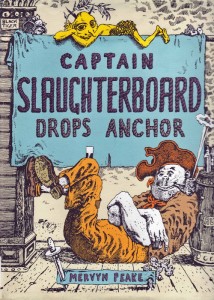
Tags: children's books, picture books
Posted in Book Reviews, Children's Books | No Comments »
Friday, December 16th, 2016
Would it be possible to find a more ungrateful boy, or one with less heart than I have! – Pinocchio
Pinocchio by Carlo Collodi (1882) is a rare thing: an archetypal story for children. The puppet-boy represents every disobedient, lazy child who must face life’s hardships, find parental love and grow up. It can also be read as a Christian allegory, a snapshot of society or as a myth. The language of this classic has barely dated. The best recent version is illustrated by Roberto Innocenti, capturing all the pathos of the tale – his iconic artwork combines painterly detail with cinematic angles. This dark, humourous adventure is a far cry from the sanitized (but beautiful!) Disney movie version.
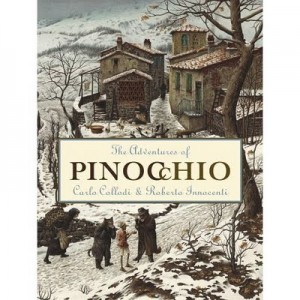
Tags: children's books, picture books, reviews
Posted in Book Reviews, Children's Books | No Comments »
Monday, May 9th, 2016
Gecko Press‘ latest picture book is that rare beast, a message book that also entertains – it’s also artfully designed with eight blank pages and sixty characters! In Don’t Cross the Line by Isabel Minhó Martins, an army general orders a guard to keep the right-hand page of the book blank. But a crowd of people build up on the border, desperately wanting to use the space. What can the guard do? People power succeeds in the end. It’s those eight blank pages that will speak to all ages about freedom: children see an empty space and want to play in it; teenagers ask why it’s forbidden; and adults see the injustice in it. A wonderful concept with lively illustrations by Bernardo Carvalho. (Read about Peace books for children here)
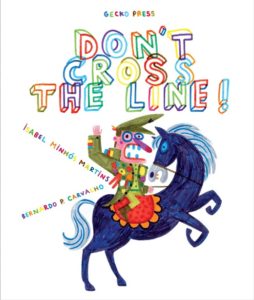
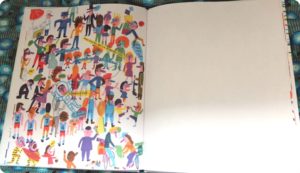
Tags: children's books, non-violence, people power, picture books, political change, reviews
Posted in Book Reviews, Peace | No Comments »
Saturday, March 19th, 2016
William Steig, (creator of Shrek) has been called ‘one of the finest cartoonists and creators of children’s books’ (Jonathan Cott). He began writing for children at 60 and his stories are often uncompromising but always celebrate the richness of relationships and nature. Steig used sophisticated language to entertain readers rather than befuddle them. 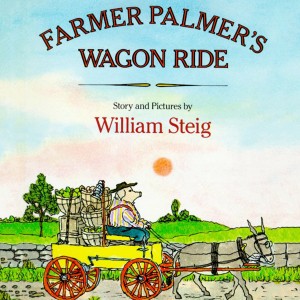
The picture book Farmer Palmer’s Wagon Ride is one of his most playful. A farmer-pig suffers a series of slapstick mishaps as he takes gifts home to his beloved family. I love his description of a rainstorm:
‘Harum-scarum gusts of wind … a drubbing deluge … thunder rambled and rumbled … it dramberamberoomed!’
Read the full article about William Steig and his books.
Tags: children's books, picture books, reviews, steig
Posted in Book Reviews, Children's Books, Humour | No Comments »
Friday, May 22nd, 2015
The best picture books are like a marriage: the text and illustrations support each other but have a strong life of their own. For very young children the plot should be focused and the pictures comforting. I Went Walking by Sue Williams is a perfect first book. The words are basic yet they incorporate repetition, questions, rhymes and humour. And the illustrations by Julie Vivas are sublime; leading the eye across the page in a dance of line, shape and colour. (See her gorgeous version of the Nativity too).
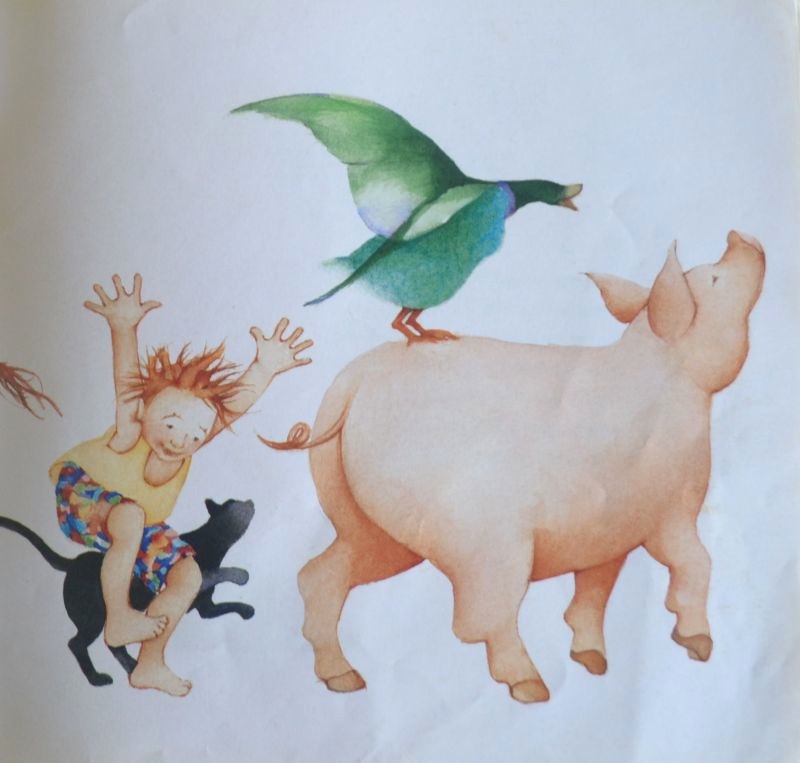
Max’s Bath by Barbro Lindgren is another delightful book for preschoolers. Max dumps his toys and his food in the tub and then tries to wash the dog with predictable results. Max is a classic ‘terrible two year old’ combining charm and mischief.
The picture book Seasons by French artist, Blexbolex is a unique, meditative book for young children that adults will relish for it’s design. It’s a tactile treat, printed in chunky hardback on rough paper, like old comic annuals. Each page has a single word and a subtle image to illustrate it. No garish colours here, just the quiet passing of seasons.
Tags: children's books, picture books
Posted in Book Reviews, Children's Books | No Comments »
Sunday, January 4th, 2015
The book has long oscillated between being accepted as harmless hilarity and being condemned as excessively horrifying- Humphrey Carpenter
Struwwelpeter (Pretty Stories and Funny Pictures) by Dr Heinrich Hoffman (1845) is a classic of gleefully gruesome cautionary rhymes about naughty children. Hoffman was a psychiatrist who founded an influential Frankfurt asylum and pioneered counselling as an alternative treatment to cold baths. The characters in Struwwelpeter were inspired by his child patients – he’d tell them stories and draw pictures to calm them down. Hoffman was looking for a book for his three year old son and could only find ‘stupid collections of pictures, and moralising stories’, so he created Struwwelpeter. It was one of the first picture books designed purely to please children – before 1850 children’s books were mainly religious and moral lessons with titles such as An Exact Account of the Conversion, Holy Lives and Joyful Deaths of Several Young Children. Read more about ‘Shock-Headed’ Peter here.
The Awful Warning carried to the point where Awe topples over into helpless laughter.– Harvey Darton
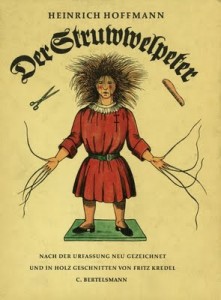
Tags: children's books, picture books, reviews, struwwelpeter
Posted in Book Reviews, Children's Books, Humour, Reading | No Comments »
Sunday, November 23rd, 2014
The Grey Lady and the Strawberry Snatcher is a classic picture book that almost didn’t make it. It took Molly Bang years to create and it was repeatedly rejected by publishers – they said it was ‘peculiar-looking’ and that ‘children won’t relate to an old woman as a protagonist’. The manuscript sat in a drawer for years, was re-worked and finally published to some critical reviews, writes Molly Bang: ‘The New York Times that said that the weird-looking characters and flashy colors were an indication that I was part of the drug culture and the detailed pictures told no real story but were merely an excuse to show off.’ Then it won a Caldecott award and everything changed. Why? It’s a one-of-a-kind, off-the-wall book, and very creepy! I love the tiny fungi that grow where the Strawberry Snatcher has trod.
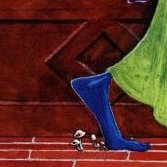
Tags: children's books, picture books, writing
Posted in Book Reviews, Children's Books, Writing | No Comments »
Sunday, August 24th, 2014
The classic picture book Calico the Wonder Horse — The Saga of Stewy Stinker by Virgina Lee Burton was published in 1941. I adored this comic-book style cowboy adventure as a child mainly because of the bad guy. Stewy Stinker is so low he steals Christmas presents from children but in the end he repents. This picture of him crying out his rottenness always made me feel sorry for him:
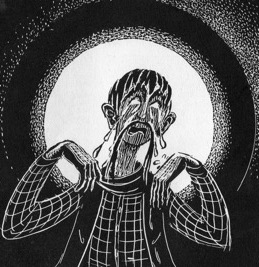
The word ‘Stinker’ was censored from the book in the 1940s as it was considered inappropriate for children. Burton was one of the great illustrators and the idea for Calico from seeing her sons engrossed with comic books. The wonderful design, cartoon framing and action scenes of Calico are worthy of a modern graphic comic: the flash flood and stagecoach crash are gripping highlights. But it’s that haunting image of Stewy that will stay with me.
Tags: children's books, picture books
Posted in Book Reviews, Children's Books | No Comments »
Thursday, August 1st, 2013
This handsome, respectful volume deserves a place on the shelf … it succeeds in accurately dramatizing honeybee behavior. – Kirkus Reviews
Flight of the Honey Bee review by artist, Claire Beynon:
“Given the state of our environment, the sooner we introduce our children to bees – to their intelligence, their intricate behaviour and increasing vulnerability – the better. Flight of the Honey Bee is the perfect book to do this, combining as it does Raymond Huber’s careful language and well-researched text with Brian Lovelock’s meticulously observed paintings. Cleverly formatted, fiction and non-fiction – story and fact – are woven together as two discreet yet interconnected strands: young readers can choose their flight path.
Exquisite to look at and a pleasure to explore.
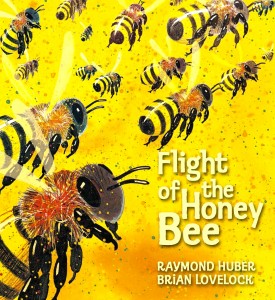 Scout the bee – named after the feisty protagonist in Harper Lee’s To Kill A Mockingbird – and her tightly-knit community of hardworking bees demonstrate these small creatures’ importance in the pollinaton of plants and the well-being of our planet. Flight of the Honey Bee is about bee behavior but it will also teach children about subtler things; wonder, beauty, the value of group functioning and collaborative effort, reproduction, risk, courage, the joys of flight – those rhythms and principles essential for any thriving community. The hum of the parts.
Scout the bee – named after the feisty protagonist in Harper Lee’s To Kill A Mockingbird – and her tightly-knit community of hardworking bees demonstrate these small creatures’ importance in the pollinaton of plants and the well-being of our planet. Flight of the Honey Bee is about bee behavior but it will also teach children about subtler things; wonder, beauty, the value of group functioning and collaborative effort, reproduction, risk, courage, the joys of flight – those rhythms and principles essential for any thriving community. The hum of the parts.
This book has all the essentials of a satisfying story: it asks questions and it informs. It invites observation and participation. There’s drama. Suspense. Conflict. Danger. Hope. And a happy ending. At the close of her adventure, Scout is a wily-er bee than she was when she set out from her hive on her first nectar-seeking adventure. As all characters must, she grows through her experiences. We come to care about her and her safe passage home.
Visually, Flight of the Honey Bee is exquisite to look at and a pleasure to explore – each double page spread is as stunning as the one preceding it. It will be immediately appealing to young readers. I was struck by how beautifully integrated the text and images are; they belong together like honey and honeycomb. The language is tender and witty (the line about ‘sun-powder’ is a wonderful change from ‘gun-powder’); and the paintings – a combination of watercolour, acrylic ink and coloured pencils – are spectacular; compositionally bold, delicate, exuberant and information-rich. Looking at them through my adult eyes, I can’t help thinking about fractals, the mathematics inherent in nature, the ever-present background dialogue between shape and sound, pattern and colour. Children will pore over them. And they will love Scout for her feisty resourcefulness.
More Flight of the Honey Bee reviews.
Tags: children's books, picture books, reviews
Posted in Bees, Book Reviews, Children's Books | No Comments »
Wednesday, May 15th, 2013
Here are three of my favourite New Zealand picture books that give children a manageable dose of horror. Gavin Bishop’s Horror of Hickory Bay has grown on me over the years. The story of a bland family on a Canterbury beach and an amorphous beast seemed a bit coarse to me 25 years ago, but now I love the earthy monster (which has a new force in quakey times). Diane Hebley said it best:
I find this book fascinating for its masterly use of colour and design, its grim humour, its coherence of idea, text and image, and for its acceptance of the dreamworld reality.
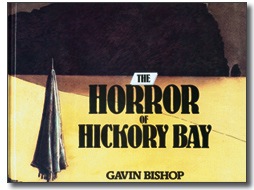
The Were-Nana by Melinda Szymanik is a creepy delight about a visiting relative who might just be a monster. The suspense is nicely built up and the double surprise ending (true to horror traditions) is brilliant. Odd cover choice but fine shadowy illustrations by Sarah Nelisiwe Anderson.
Te Kapo the Taniwha by Queen Rikihana-Hyland is out of print but was always popular in class. It’s the story of a half-man, half-monster who was given the job of shaping the South Island. Zac Waipara’s pictures are stunning as usual.
Tags: children's books, picture books, reviews
Posted in Book Reviews, Children's Books | No Comments »
Thursday, February 23rd, 2012
After reading Wolfram’s dramatic story I discovered his daughter’s wonderful art. Alexandra Milton is an animal artist and children’s book illustrator. She creates her creatures by collage, using hand-made papers with mysterious names: Korean mingeishi, Thai silk thread, Himalayan khadi, and Payhembury marbled paper. Her honey bee illustration below is warm and characterful (like bees).
I aim to celebrate all that is to be marvelled at in nature; to catch, in colour and form, a glimpse of the miracle of creation Alexandra Milton
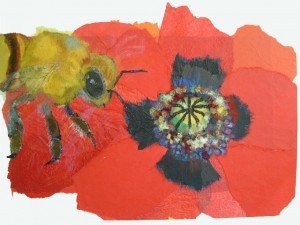
Tags: art, children's books, honey bees, picture books
Posted in Bees, Children's Books | No Comments »
Wednesday, December 7th, 2011

In The Crab With the Golden Claws (1940). Herge introduced one of literature’s best characters: Captain Haddock– and one of the most faithful friendships. The drunken, cursing Captain is a perfect foil to the angelic Tintin. Herge hoped that some of Haddock’s frailties would rub off on Tintin, but as he wrote in a letter to Tintin,
…you took nothing from him, not even a tot of whisky. My wrist was seized by an Angel…
Read more…
Tags: children's books, picture books, Tintin
Posted in Children's Books | No Comments »
Sunday, December 4th, 2011
Struwwelpeter (1845) by Dr. Heinrich Hoffman has gruesome rhymes about disobedience and its dire consequences. The creepiest tale is in The Story of Little Suck-a-Thumb:
Snip! Snap! Snip! the scissors go
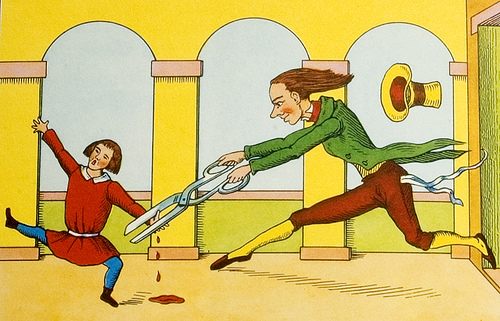
It sounds best in the original ‘klipp und klapp!’ of the German. Less well known is the Nazi parody version Struwwelhitler (1941). Read the full story here.
Tags: children's books, picture books
Posted in Children's Books | No Comments »























